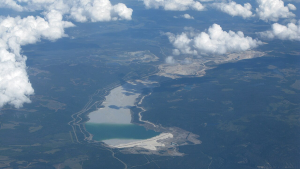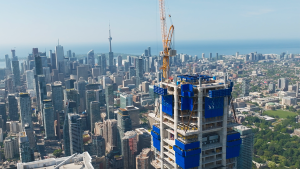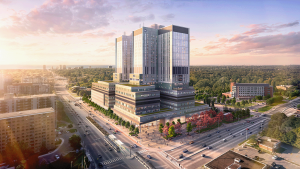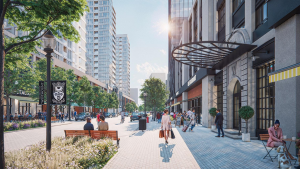From perhaps America’s most notorious public housing project to a variegated contemporary mixed-income site, a central area of the former Cabrini-Green neighborhood also has been given a more upscale name, Parkside of Old Town.
This summer the Chicago Housing Authority (CHA) announced the fifth and final phase of the rebuilding of part of the former 70-acre Cabrini-Green projects, designed to blend into a wider gentrified neighborhood on the city’s near northside.
This includes 99 apartments in four buildings – an eight-storey midrise and three, three-storey walkups – along with a community and fitness center. A deliberate departure from the previous homogenous low-income housing towers, the project, like earlier phases, offers a mixture of low income, affordable and market rate units.
While the announcement has been welcomed, Parkside, along with other developments within the former Cabrini-Green 70-acre footprint, have only come in fits and starts and the massive site is still far from being fully reinvented.
The poster child for the ills of post-Second World War public housing, Cabrini-Green’s rebirth began in 2000 with former mayor Richard M. Daley’s “Plan for Transformation.” The last of the eyesore towers met the wrecking ball in 2011.

During its heyday Cabrini-Green captured the international imagination of the dystopia of the worst of public housing – crime, blight and the creation of racial ghettos. Perhaps some of that was unfair, generated by a TV show like Good Times, supposedly set in the projects. The 1990s horror film Candyman also didn’t help. And former mayor Jane Byrne created headlines in the early 1980s camping out there, trying to bring a measure of stability.
“The stark, monotonous highrises, with fenced in balconies, made it look forbidding and prison like,” Brad Hunt, author of a book on Chicago public housing, Blueprint for Disaster, and chair of Loyola University’s history department, said.
By contrast, according to CHA spokesman Matt Aguilar, the Parkside buildings “will be clean and modern, with careful use of color, form and texture to create visual appeal. The design will continue to add to the vibrant mixed-income community with amenities that benefit all residents.”
Other individual developments within Cabrini-Green have preceded this or are coming.
To date the CHA and public and private partners have built 3,500 rental and even saleable housing units (including 1,226 low income and 867 affordable) on 25 mixed-income sites. On Parkside Phase 5, Holsten Real Estate Development Corporation and the Cabrini Green Local Advisory Council Development Corporation are the developers.
While Parkside is located more centrally within the former Cabrini-Green footprint south of West Division Street, the CHA is also currently seeking rezoning approval for a 560-unit development at Larrabee Street and Clybourn Avenue, which diagonally bisects part of the area, on seven long vacant acres in the northwest corner. Another 78-unit project, located several blocks south at Larrabee and Oak streets, is expected to begin this year.
Among other things, Cabrini-Green’s redevelopment has long been criticized for its clumsiness in forcing out former residents without suitable alternative housing, resulting in a lawsuit settled in 2006, along with the financing problems associated with the 2008 Great Recession.
Hunter calls the entire redevelopment a “legal and political odyssey, contested or neglected at nearly every step of the way.”
And despite the slow pace of redevelopment “we’re still a long way from completion, with large vacant lots still littering the landscape.”
Hunter said the transformation to low rise contemporary designs is a direct antidote to the former “eyesore” of highrise buildings such that the CHA wants “any new housing to ‘not’ look like public housing.”
This means “current vernacular styles – either new-urbanist townhomes that harken back to 19th century architectural styles, with lots of brick and big front steps – or sleek modern townhouses that couldn’t possibly be confused with the old highrises.”
Why are there so many market rate units replacing the once entirely low-income ones?
Hunter suggests the CHA was “concerned about over-concentrating public housing again, so they want the market-rate housing to go first.”
The CHA’s CEO Tracey Scott describes her vision in the CHA’s 2022 annual report as creating a city “filled with sustainable mixed-use, mixed-income neighborhoods where everyone feels welcome and can thrive.”
Has Cabrini-Green’s redevelopment, and similar other neighborhood efforts helped transform Chicago’s public housing?
“To the extent that the architecture stereotype is removed, the rebuilding is a good thing,” Hunter says.
But the “slow and incomplete Plan for Transformation has not helped address Chicago’s affordable housing crisis, a huge, missed opportunity for the CHA to become an active and dynamic developer of affordable housing in the city.”











Recent Comments